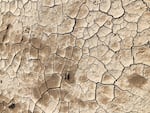Even after recent rain and snow, the western U.S. is facing another year of extreme drought. Last week, Governor Kate Brown declared drought emergencies in four more Oregon counties, bringing the total to 11.
Water managers in Oregon and across the West will have to decide where slim resources should go. But those water managers are relying on outmoded data, says Andrew Schwartz, who manages the Central Sierra Snow Laboratory for the University of California at Berkeley.

The dry bed of Detroit Lake is pictured in this Oct. 25, 2015, file photo.
Courtney Sherwood
For one thing, he says, climate scientists need to spend more time looking at the ground.
“When we have these extended droughts, our soil dries out quite a lot,” says Schwartz. “That means that any new rain or snow that comes in can immediately be soaked up by that soil and reduces the amount of it that’s going into our streams and then our reservoirs.”
Schwartz says that these dry soils also make forest fires more likely. That, in turn, lessens the tree canopy that would have provided shade over snow, thus causing the snow to melt faster and dry out the soil further.

An aerial view of the forest surrounding Jawbone Flats, where the Beachie Creek Fire burned nearly 200,000 acres.
Daniel Hurst / OPB
“All these processes have existed in the past, but the variability in them from year to year or the droughts from year to year haven’t been as extreme,” Schwartz says. Now “we see the severity increasing with anthropogenic climate change.”
The consequence of this modeling may mean that water managers are making the wrong decisions about where slim resources should go.
“If these models overestimate, for instance, our water that’s going to be coming into the reservoirs, we may be releasing water that we don’t have the opportunity to waste,” says Schwartz. “So that could mean less water for everyday people, less water in your taps — potentially even entire towns going dry.”




